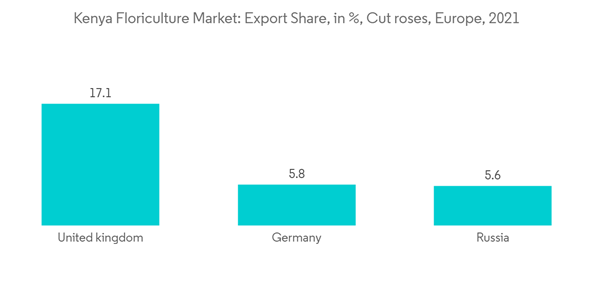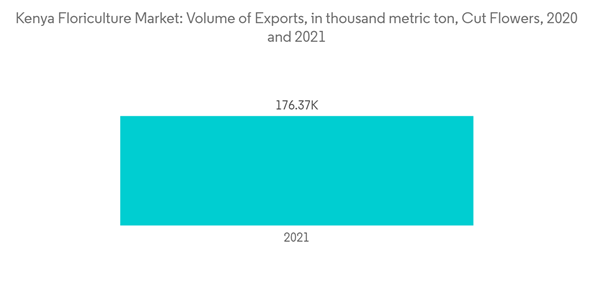Key Highlights
- Kenya's economy is heavily reliant on agriculture. The floriculture sub-sector is one of the country's leading foreign exchange earners. The Kenyan flowers are exported to over 60 nations. The flowers grown mainly in Kenya are roses, carnations, alstromeria, gypsophilla, lilies eryngiums, arabicum, hypericum, and statice, among others. The favorable climatic conditions are increasing the production of flowers in the country, which drives the market's growth.
- Additionally, the industry employs a vast number of people in the country. According to the Embassy of the Republic of Kenya in Japan, it is estimated that the floriculture business employs over 500,000 Kenyans, including over 100,000 flower farm workers, and affects over 2 million livelihoods. The production takes place around Lake Naivasha, Mt. Kenya, Nairobi, Thika, Kiambu, Athi River, Kitale, Nakuru, Kericho, Nyandarua, Trans Nzoia, Uasin Gishu, and Eastern Kenya.
- Along with this, rose is witnessing immense popularity in the country. Delphinium, Limonium, and Helianthus are the most popular growing facilities for roses in Kenya. It is a leading exporter of rose-cut flowers to the European Union (EU). Its total exports of cut roses were valued at USD 550.9 million in 2021.
- Furthermore, some of the most common technologies utilized in the entire cold chain of Kenyan flower farming include drip irrigation, fertigation systems, glasshouse ventilation systems, net shading, pre-cooling, cold storage facilities, artificial lightning, and refrigerated trucks. Therefore, the usage of the improved technologies produces good quality flowers, thereby contributing to the market growth in the forecast period.
Kenyan Floriculture Market Trends
Rising Export Potential of Floral Products
- The floriculture industry is well-developed in Kenya. It contributes to more than 1% of the country's GDP. Popular flowers, such as roses, carnations, lilies, leaf cuttings, and decorative plants, are primarily exported by the country. The production of these flowers is increasing yearly, giving rise to exports to various countries. According to the Kenya Flower Council, flower sales generated USD 993 million in 2020. In Kenya, most of the floriculture products are produced to meet the needs of exports.
- Additionally, Kenya is one of the major exporters of cut flowers worldwide. This sector in Kenya represents the third-largest foreign exchange earner. Additionally, Kenya sells 70 percent of its flowers to European countries. The main export markets include the Netherlands, followed by the United Kingdom, Germany, and Norway, with an export share of 43.3, 17.1, 5.8, and 5.6, respectively. Moreover, approximately half of all exported flowers from Kenya are being sold in Dutch auctions.
- Also, supermarkets are the most common retail outlets in the United Kingdom. More than 25% of these exported flowers are sent straight to these retailers, creating a potential for value addition at the source through bouquet production and sleeving, labeling, and packaging, thereby increasing the growth potential in the international markets.
- Roses have the potential for expansion, owing to reasons such as large production acreage, stable production throughout the year, and the fact that cultivators have a high standard of SOP for producing high-quality, along with high demand from international markets. For instance, the export value of cut roses increased from USD 462,834 thousand in 2020 to USD 550,998 thousand in 2021.
- The main export destinations for fresh roses are the Netherlands, the United Kingdom, and the Russian Federation. These countries accounted for a share of 70.7% in 2020. Therefore the increase in the growth potential of roses contributes to the market growth in the forecast period.
Increasing Support from Government and Public Sectors
The flower industry is well developed in Kenya, with farmers using the latest technologies such as greenhouse technology, micro irrigation systems, etc., which will benefit production. Along with this, there are about 220 flower farms in Kenya, about 70 of which are located near Lake Naivasha. Thus, the floriculture industry earns a good amount of foreign exchange. So, the Kenyan Ministry of Agriculture is focusing on driving the adoption of floriculture through various policies, regulations, and operational directions.The government invested a huge amount in cultivation, along with favorable policies to increase production. This is attracting foreign investments, which are increasing production and thereby increasing the exports of floriculture products. For instance, the export volume of cut flowers has increased from 2020 141,216 metric tons to 176,372 metric tons in 2021. In addition, the government of Kenya is prioritizing the creation of smallholder farmers' aggregation and logistics facilities and investment in their market infrastructure.
Along with this, the government established quarantine and fumigation facilities in response to a decrease in flower exports to Australia and Japan due to the lack of appropriate facilities.
Furthermore, the market is implementing advanced technologies and infrastructures for floriculture. In Kenya, the different ministries that are in favor of floriculture are Water and Irrigation, Health, Environment, and Natural Resources, Local Government, Cooperative Development and Marketing, Trade, and Regional Development Authorities. The other public sectors include the Kenya Plant Health Inspectorate Services (KEPHIS), which helps regulate phytosanitary and seed issues by providing plant variety protection and seed certification. The Horticultural Crops Development Authority (HCDA) is one of the major organizations responsible for facilitating, developing, promoting, and regulating horticulture techniques in Kenya. Additionally, the USAID hub signed a grant with the Kenyan government in December 2019, which is expected to boost the market share of Kenya in the US cut flower market. Therefore, the initiatives from the government, along with the government favoring the public sector, are contributing to the market's growth.
Kenyan Floriculture Industry Overview
Additional Benefits:
- The market estimate (ME) sheet in Excel format
- 3 months of analyst support
This product will be delivered within 2 business days.










